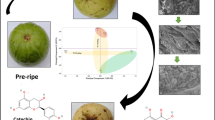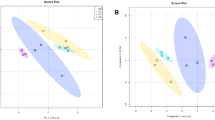Abstract
Noni (Morinda citrifolia) fruit is one of the traditional medicine materials widely consumed in the South Pacific area. The biological activities and medicinal values of noni fruit have been extensively documented. However, the chemical composition of noni fruit, which determines its pharmacological effects, remains unclear. Moreover, previous studies indicated that the medicinal values of noni fruit varies dynamically after harvest, which resulted in the quality instability of both fresh and processing noni products. To clarify the composition of metabolites in noni fruit and their variation patterns, non-targeted metabolome analysis was performed at different stages during postharvest storage. It was observed that (R)-3, 7-Dihydroxy-2, 4-dimethoxyisoflavan, 3-Hydroxy-5Z-octenyl acetate, Ancistrotectorine, Archange- licin, D-Tagatose, (−)-Epigallocatechin, Ethylsuberenol, Eugenitin, Garcimangosone C, Musanolone C, O-Isopentenylhalfordinol and Serotinose were highly accumulated in fresh fruit, which associated with the roles of noni fruit in antioxidant activity. On the contrary, Palmitic acid, Norecasantalol, Marmelolactone A, Isorhamnetin 3-(6-malonylglucoside), Isooctyl acetate, geranylacetone, Ethylparaben, Ethyl (4Z)-4,7- octadienoate, DL-Malic acid, Coumari, Cedrelanol, Carotol, BR-Xanthone A, 5-Dodecyldihydro-2(3H)-furanone, (Z)-alpha-Irone, and (2E,4E)-2,4-Dodecadienal were increasing significantly after harvest, which not only could be explained the natural antibacterial properties of noni fruit but also supported the healthy immune system and inflammation response. Our study provides new insights into the metabolites composition and their variation patterns after harvest in noni fruit.




Similar content being viewed by others
References
Ahmed AS, Charles PD, Cholan R, Russia M, Surya R, Jailance L (2015) Antibacterial efficacy and effect of Morinda citrifolia L. mixed with irreversible hydrocolloid for dental impressions: a randomized controlled trial. J Pharm Bioallied Sci 7:S597–S599
Almeida-Souza F, Taniwaki NN, Amaral AC, de Souza CS, Calabrese Kda S, Abreu-Silva AL (2016) Ultrastructural changes and death of Leishmania infantum promastigotes induced by Morinda citrifolia Linn. Fruit (noni) juice treatment. Evid-Based Compl Alt Med 2016:506–540
Benoit SC, Kemp CJ, Elias CF, Abplanalp W, Herman JP, Migrenne S, Lefevre AL, Cruciani-Guglielmacci C, Magnan C, Yu F, Niswender K, Irani BG, Holland WL, Clegg DJ (2009) Palmitic acid mediates hypothalamic insulin resistance by altering PKC-theta subcellular localization in rodents. J Clin Invest 119:2577–2589
Boonanantanasarn K, Janebodin K, Suppakpatana P, Arayapisit T, Rodsutthi JA, Chunhabundit P, Boonanuntanasarn S, Sripairojthikoon W (2014) Morinda citrifolia leaves enhance osteogenic differentiation and mineralization of human periodontal ligament cells. Dent Mater J 33:157–165
Candida T, França JP, Chaves AL, Lopes FA, Gaiba S, Sacramento CK, Ferreira LM, França LP (2014) Evaluation of antitumoral and antimicrobial activity of Morinda lcitrifolia L. grown in Southeast Brazil. Acta Cir Bras 29:10–14
Caramel S, Marchionni M, Stagnaro S (2015) Morinda citrifolia plays a central role in the primary prevention of mitochondrial-dependent degenerative disorders. Asian Pac J Cancer Prev 16:1675
Cárdenas-Coronel WG, Carrillo-López A, Vélez-de-la-Rocha R, Labavitch JM, Báez-Sañudo MA, Heredia JB, Zazueta-Morales JJ, Vega-García MO, Sañudo JA (2016) Biochemistry and Cell Wall changes associated with noni (Morinda citrifolia L.) fruit ripening. J Agric Food Chem 64:302–309
Chiu CJ, Liu S, Willett WC, Wolever TM, Brand-Miller JC, Barclay AW, Taylor A (2011) Informing food choices and health outcomes by use of the dietary glycemic index. Nutr Rev 69:231–242
Ee GC, Daud S, Taufiq-Yap YH, Ismail NH, Rahmani M (2006) Xanthones from Garcinia mangostana (Guttiferae). Nat Prod Res 20:1067–1073
Ensor M, Williams J, Smith R, Banfield A, Lodder RA (2014) Effects of three low-doses of D-tagatose on glycemic control over six months in subjects with mild type 2 diabetes mellitus under control with diet and exercise. J Endocrinol Diabetes Obes 2:1057
Franchi LP, Guimarães NN, De Andrade LR, De Andrade HH, Lehmann M, Dihl RR, Cunha KS (2013) Antimutagenic and antirecombinagenic activities of noni fruit juice in somatic cells of Drosophila melanogaster. An Acad Bras Cienc 85:585–594
Giovannoni JJ (2007) Fruit ripening mutants yield insights into ripening control. Curr Opin Plant Biol 10:283–289
Gooda Sahib Jambocus N, Saari N, Ismail A, Khatib A, Mahomoodally MF, Abdul Hamid A (2016) An Investigation into the Antiobesity Effects of Morinda citrifolia L. Leaf extract in high fat diet induced obese rats using a (1)H NMR metabolomics approach. J Diabetes Res 2016:2391592
Hu MX, Zhang HC, Wang Y, Liu SM, Liu L (2012) Two new glycosides from the fruits of Morinda citrifolia L. Molecules 17:12651–12656
Huang YL, Chen CC, Chen YJ, Huang RL, Shieh BJ (2001) Three xanthones and a benzophenone from Garcinia mangostana. J Nat Prod 64:903–906
Huang HL, Ko CH, Yan YY, Wang CK (2014) Antiadhesion and anti-inflammation effects of noni (Morinda citrifolia) fruit extracts on AGS cells during helicobacter pylori infection. J Agric Food Chem 62:2374–2383
Huang HL, Liu CT, Chou MC, Ko CH, Wang CK (2015) Noni (Morinda citrifolia L.) fruit extracts improve Colon microflora and exert anti-inflammatory activities in Caco-2 cells. J Med Food 18:663–676
Jasicka-Misiak I, Lipok J, Nowakowska EM, Wieczorek PP, Młynarz P, Kafarski P (2004) Antifungal activity of the carrot seed oil and its major sesquiterpene compounds. Z Naturforsch C 11:791–796
Ji X, Avula B, Khan IA (2007) Quantitative and qualitative determination of six xanthones in Garcinia mangostana L. by LC-PDA and LC-ESI-MS. J Pharm Biomed Anal 43:1270–1276
Kannan S, Manickam S, RajaMohammed MA (2014) Anxiolytic, sedative, and hypnotic activities of aqueous extract of Morinda citrifolia fruit. J Ayurveda Integr Med 5:73–75
Khan Y, Pandy V (2016) Methanolic extract of Morinda citrifolia L. (noni) unripe fruit attenuates ethanol-induced conditioned place preferences in mice. Front Pharmacol 7:352
Lim SL, Goh YM, Noordin MM, Rahman HS, Othman HH, Abu Bakar NA, Mohamed S (2016) Morinda citrifolia edible leaf extract enhanced immune response against lung cancer. Food Funct 7:741–751
Liu RH, Wen XC, Shao F, Zhang PZ, Huang HL, Zhang S (2016) Flavonoids from heartwood of Dalbergia cochinchinensis. Chin Herb Med 8:89–93
Luis JG, Quiñones W, Echeverri F, Grillo TA, Kishi MP, Garcia-Garcia F, Torres F, Cardona G (1996) Musanolones: four 9-phenylphenalenones from rhizomes of Musa acuminata. Phytochem 41:753–757
Mondego-Oliveira R, Almeida-Souza F, de Sa JC, Oliveira Torres MA, de Andrade FHE, Almeida Melo F, da Silva CK, Abreu-Silva AL (2015) Noni fruit extract induces effective control of lesions in mice infected with with Leishmania amazonensis. J Anim Vet Adv 14:151–154
Murata K, Abe Y, Futamura-Masudaa M, Uwaya A, Isami F, Matsuda H (2014) Activation of cell-mediated immunity by Morinda citrifolia fruit extract and its constituents. Nat Prod Commun 9:445–450
Narasingam M, Pandy V, Mohamed Z (2016) Noni (Morinda citrifolia L.) fruit extract attenuates the rewarding effect of heroin in conditioned place preference but not withdrawal in rodents. Exp Anim 65:157–164
Nayak BS, Marshall JR, Isitor G, Adogwa A (2011) Hypoglycemic and hepatoprotective activity of fermented fruit juice of Morinda citrifolia (noni) in diabetic rats. Evid-Based Compl Alt Med 2011:875293
Nerurkar PV, Nishioka A, Eck PO, Johns LM, Volper E, Nerurkar VR (2012) Regulation of glucose metabolism via hepatic forkhead transcription factor 1 (FoxO1) by Morinda citrifolia (noni) in high-fat diet-induced obese mice. Br J Nutr 108:218–228
Osorio S, Alba R, Nikoloski Z, Kochevenko A, Fernie AR, Giovannoni JJ (2012) Integrative comparative analyses of transcript and metabolite profiles from pepper and tomato ripening and development stages uncovers species-specific patterns of network regulatory behavior. Plant Physiol 159:1713–1729
Piaru SP, Mahmud R, Abdul Majid AM, Mahmoud Nassar ZD (2012) Antioxidant and antiangiogenic activities of the essential oils of Myristica fragrans and Morinda citrifolia. Asian Pac J Trop Med 5:294–298
Pratap UP, Anand K, Yasmine F, Hima L, Priyanka HP, Thyagarajan S (2016) Phytochemicals in Morinda citrifolia fruit selectively modulate age-associated immunity and antioxidant enzyme activities through ERK pathway in splenic lymphocytes of male F344 rats. J Recept Signal Transduct Res 36:139–151
Ratnoglik SL, Aoki C, Sudarmono P, Komoto M, Deng L, Shoji I, Fuchino H, Kawahara N, Hotta H (2014) Antiviral activity of extracts from Morinda citrifolia leaves and chlorophyll catabolites, pheophorbide a and pyropheophorbide a, against hepatitis C virus. Microbiol Immuno l58:188–194
Samoylenko V, Zhao J, Dunbar DC, Khan IA, Rushing JW, Muhammad I (2006) New constituents from noni (Morinda citrifolia) fruit juice. J Agric Food Chem 54:6398–6402
Selvam P, Maddali K, Marchand C, Pommier Y (2010) Studies of HIV integrase inhibitory activity of Morinda citrifolia L. noni fruit extracts. Antivir Res 86:45–46
Sharma K, Pachauri SD, Khandelwal K, Ahmad H, Arya A, Biala P, Agrawal S, Pandey RR, Srivastava A, Srivastav A, Saxena JK, Dwivedi AK (2016) Anticancer effects of extracts from the fruit of Morinda Citrifolia (noni) in breast Cancer cell lines. Drug Res (Stuttg) 66:141–147
Sridhar SR, Rajagopal RV, Rajavel R, Masilamani S, Narasimhan S (2003) Antifungal activity of some essential oils. J Agric Food Chem 51:7596–7599
Sukamporn P, Rojanapanthu P, Silva G, Zhang X, Gritsanapan W, Baek SJ (2016) Damnacanthal and its nanoformulation exhibit anti-cancer activity via cyclin D1 down-regulation. Life Sci 152:60–66
Tin SS, Wiwanitkit V (2014) Morinda citrifolia fruit and anxiolytic effect. J Ayurveda Integr Med 5:140
Wang MY, West BJ, Jensen CJ, Nowicki D, Su C, Palu AK, Anderson G (2002) Morinda citrifolia (noni): a literature review and recent advances in noni research. Acta Pharmacol Sin 23:1127–1141
Wang MY, Nowicki D, Anderson G, Jensen J, West B (2008) Liver protective effects of Morinda citrifolia (noni). Plant Foods Hum Nutr 63:59–63
Whistler WA (1985) Traditional and herbal medicine in the Cook Islands. J Ethnopharmacol 13:239–280
Wold S, Esbensen K, Geladi P (1987) Principal component analysis. Chemom Intell Lab Syst 2:37–52
Wu YG, Girmay S, da Silva VM, Perry B, Hu X, Tan GT (2015) The role of endophytic Fungi in the anticancer activity of Morinda citrifolia Linn. (noni). Evid-Based Compl Alt Med 2015:393960
Yang CS, Wang X, Lu G, Picinich SC (2009) Cancer prevention by tea: animal studies, molecular mechanisms and human relevance. Nat Rev Cancer 9:429–439
Youn UJ, Park EJ, Kondratyuk TP, Sang-Ngern M, Wall MM, Wei Y, Pezzuto JM, Chang LC (2016) Anti-inflammatory and Quinone reductase inducing compounds from fermented noni (Morinda citrifolia) juice exudates. J Nat Prod 79:1508–1513
Zin ZM, Abdul-Hamid A, Osman A (2002) Antioxidative activity of extracts from Mengkudu (Morinda citrifolia L.) root, fruit and leaf. Food Chem 78:227–231
Acknowledgements
This work was supported by a grant from the Applied Basic Research Programs of Yunnan Province of China (No. 2016FB049).
Author information
Authors and Affiliations
Corresponding author
Ethics declarations
Conflict of Interest
The authors declare no competing financial interest.
Additional information
Communicated by: Robert Paull
Publisher’s Note
Springer Nature remains neutral with regard to jurisdictional claims in published maps and institutional affiliations.
Rights and permissions
About this article
Cite this article
Wu, T., Li, M. & Lan, Z. Reveal the Variation Patterns of Chemical Composition in the Fruit of Morinda citrifolia (noni) during Postharvest Storage through Metabolomic Characterization. Tropical Plant Biol. 12, 85–97 (2019). https://doi.org/10.1007/s12042-019-09222-6
Received:
Accepted:
Published:
Issue Date:
DOI: https://doi.org/10.1007/s12042-019-09222-6




